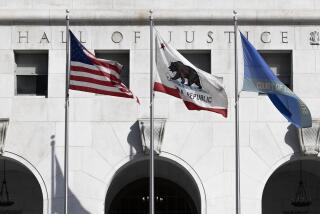Reforming the Civil Courts
- Share via
The ultimate in desperation tactics is represented by the Los Angeles County Bar Assn.’s decision to sue in federal court as a means of attacking the mess of our civil courts (Metro, Nov. 19). More judges are undoubtedly needed. But unless more basic reform of a comprehensive nature occurs, the addition of more judges will be Band-Aid treatment for a problem that has cancerous characteristics.
For decades bar groups, judges and litigation attorneys have been aware of the growing mess and many of them have striven conscientiously but too often counterproductively to find better ways to deal with a case traffic flow.
The need for basic re-engineering of a civil justice court system with uniform rules of evidence and procedure has been long overdue. However, instead of any comprehensive reform being attempted, the matter of change has been left to parochial or individual influences causing ad hoc legislative measures and a thicket of variable bureaucratic rules and procedures.
After 30 years of litigation practice, including 14 years of teaching procedure and practice, I still find that most of my client’s budget is consumed by research of procedural wrinkles and wrinkles on wrinkles regularly added by bar groups or judges using a tinker-toy method of responding to the need for reform.
The cost of litigation is ridiculously high. Many people with serious concerns cannot afford a competent attorney.
In any event, with the Bar’s federal lawsuit and other to-do about adding judges as a solution, the more fundamental need for revamping judicial methods to obtain more uniformity and therefore more efficiency by judges and lawyers is apt to be overlooked.
To illustrate: Suppose a person breaks a leg by slipping and falling 1--in his place of employment, or 2--on a cruise ship during a vacation trip on the high seas, or 3--on the floor of a federal building, or 4--on a city sidewalk.
Ask the most knowledgeable attorney you know (or judge) if he or she can competently outline the specific jurisdictional, procedural, evidentiary and general case processing rules and expense to be expected in seeking judicial relief. If you find one who can promise competent legal assistance for a reasonable fee in all of these instances, please send me his name as a candidate for the lawyer of the land award.
Yes, there is a need for more judges. But more fundamentally there is a need for a federal or state task force to simplify and unify methods of case management by lawyers and judges.
PAUL L. FREESE
Los Angeles


